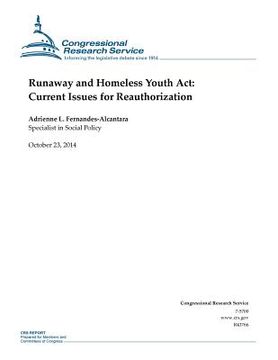Reseña del libro "Runaway and Homeless Youth Act: Current Issues for Reauthorization (en Inglés)"
The Runaway and Homeless Youth program is authorized by the Runaway and Homeless Youth Act, and funds organizations throughout the country to provide services to youth who have run away and/or experience homelessness. The program, which is administered by the U.S. Department of Health and Human Services (HHS), includes three components: (1) the Basic Center program (BCP), which provides outreach, temporary shelter, and counseling for up to 21 days to youth under age 18 who have run away or are homeless; (2) the Transitional Living program (TLP), which supports residential services and services to youth ages 16 through 21 for up to 18 months; and (3) the Street Outreach program (SOP), which provides street-based outreach and education-including treatment and referrals-for runaway and homeless youth who have been subjected to sexual abuse and exploitation or are otherwise on the street. Funding authorization for the programs expired on September 30, 2013. The federal government, led by an independent agency known as the U.S. Interagency Council on Homelessness (USICH), has developed a plan for ending youth homelessness. In 2010, USICH released Opening Doors, which included goals of ending chronic homelessness and homelessness among youth and other specified populations. An amendment to the plan in 2012 specifically introduced the Federal Framework to End Youth Homelessness, which includes improved data collection on these youth and developing and testing effective intervention models. This plan is consistent with the 2008 reauthorization of the Runaway and Homeless Youth program, which directed HHS to estimate the number of youth who have run away or are homeless and to assess the characteristics of these youth. Congress may wish to determine whether actions taken by HHS and its partners are addressing the data requirements in the law. Related to this, little is known about the outcomes of youth who participate in programs funded under the act. Congress may also be interested in the extent to which the Runaway and Homeless Youth program should more actively engage the families of runaway and homeless youth. Family conflict is a primary reason why youth leave home or are forced to leave home. The Runaway and Homeless Youth Act addresses family relationships primarily through the BCP. Some providers have models for helping build stronger connections between youth and their families. Another issue that may be of interest is demand. The programs serve a small fraction of the overall number of youth believed to be runaway or homeless, and the number of youth turned away from the BCP and TLP due to a lack of capacity has ranged from about 9,000 to 11,000 annually. Advocates assert that additional funding is needed to serve more youth, particularly because other federal funding sources for homeless service are believed to be limited. For example, the Continuum of Care (CoC) program directs homeless service providers to coordinate with runaway and homeless youth providers; however, CoC funding may not be available to some Runaway and Homeless Youth program grantees that are already not CoC funded. Finally, runaway and homeless youth tend to have multiple challenges. Congress may consider the role that the Runaway and Homeless Youth Act could play in meeting the specific needs of youth who identify as lesbian, gay, bisexual, transgendered, or questioning (LGBTQ); youth who are sex trafficked; and youth who are or were engaged in foster care or the juvenile justice system. For example, recent research on LGBTQ youth suggests that some RHY providers have difficulty identifying this population and could benefit from technical assistance for serving them effectively. In addition, runaway and homeless youth appear to be vulnerable to sex trafficking and some have a history of such victimization. The act could be amended to ensure that training and technical assistance is available to RHY providers to assist particular groups of youth

